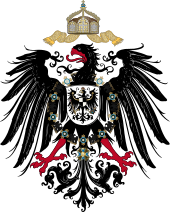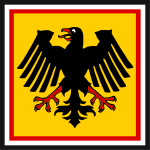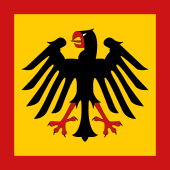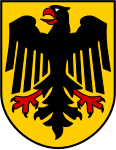Federal coat of arms of Germany
| Federal coat of arms of Germany | |
|---|---|

|
|
| Versions | |
 Federal shield as on the federal institutions flag is used |
|
| Details | |
| Introduced | January 20, 1950 |
| Heraldic shield | Federal eagle in a golden shield |
| Previous versions |
various since the 12th century |
The federal coat of arms is the national coat of arms of the Federal Republic of Germany . It shows the colors of the flag of Germany ( black-red-gold ). The national emblem shows the federal eagle as a single-headed black eagle , the head turned to the right , the wings open, but with closed plumage, beak, tongue and fangs of red color on a golden-yellow coat of arms tapering to a point at the bottom . The coat of arms is identical to the Reich coat of arms , that of Karl-Tobias SchwabThe national coat of arms of the German Empire during the Weimar Republic , designed in 1926 and in use from 1928 , the eagle of which is still called the Imperial Eagle .
The federal coat of arms differs from the federal shield, the semicircular shield reserved for the German federal authorities and the Bundeswehr for service flags and troop flags with a different representation of the federal eagle. The Federal coat of arms next to the Federal shield, the Federal Siegel , the German flag , the national anthem , the federal capital and the Day of German Unity , a state symbol of Germany, but without constitutional or statute law .
history

The German coat of arms, in gold, with a stylized red armored black eagle looking to the right, is one of the oldest state symbols in the world and - alongside the coat of arms of the Republic of Austria , which has the same origins - the oldest European emblem that still exists today. Its origins go back well before the age of the nation states.
In ancient times, the eagle was considered a messenger from the gods. In Greek mythology he symbolizes Zeus , with the Romans Jupiter and with the Teutons the main god Odin . In addition to the divine eternity, it also symbolizes courage and strength, which is why the bird was often depicted on military banners. Since about 100 BC The eagle was the highest-ranking standard of the Roman legions . In the Roman imperial cult a soaring eagle symbolized the apotheosis of the deceased emperor.
The gold on the coat of arms indicates the sacred meaning of the empire . The black color of the eagle results from the heraldic pursuit of a contrasting tinge , which is due to the interest of a good perception from a distance.
When Charlemagne transferred the Roman empire to himself as ruler of the Franconian Empire in the year 800 according to the imperial idea of the Translatio imperii , he also took over the Aquila , the legionary eagle of Roman standards , as a symbol of the universal imperial authority over the Roman Empire . As Richer von Reims reported and Thietmar von Merseburg confirmed, he had a metal, presumably golden eagle attached to his palace in Aachen , which was still there at the time of Henry IV .
At that time, the eagle did not symbolize a specific state among others, but the idea of the universal worldly order in general, the idea of empire , just as the Holy Roman Empire was initially intended to be supranational and universal. Over the centuries the eagle underwent multiple changes as an imperial eagle , from an imperial to a state symbol associated with the term “Germany”, as well as to a symbol of freedom and finally to a national symbol . Parallel to the emergence of nationally oriented states such as France or England , the eagle symbol began to forge a closer relationship with Germany, as the German kings who were not crowned emperors also led the eagle due to the personal connection between the Roman emperor and the German kingship.
Middle Ages and Early Modern Times
German Confederation (1815–1866)
The German Confederation , established in 1815, was essentially a defense alliance with a limited federal purpose , in particular a confederation of states . It was avoided to adopt an actual federal symbol, but provisionally made do with the Austrian double-headed eagle , since Austria presided over the German Bundestag . In order to accommodate the German unification movement, the Bundestag finally declared the double-headed eagle to be the national coat of arms on March 9, 1848 .
Shortly afterwards, in April and May 1848, a German national assembly was elected in Frankfurt . It established a provisional constitutional order and also empire power for the emerging revolutionary empire of that time. The new imperial organs took the place of the Bundestag . On November 12, 1848, the National Assembly agreed on the Imperial Law on the introduction of a German war and trade flag . She placed a double-headed eagle in the upper corner of the black, red and gold flag . After the suppression of the revolution and the forcible dissolution of the National Assembly, Prussia tried to unite small Germany or at least northern Germany with the Erfurt Union . At the latest with the complete restoration of the Bundestag in 1851, the federal double-headed eagle also disappeared from the scene again.
North German Confederation and German Empire (1867–1918)
When the North German Confederation was founded in 1866/67, the double-headed eagle was no longer an option because Austria-Hungary led it, but the eagle was undisputed as the German national symbol. It then returned to the Empire in 1871 in its original, one-headed form as an imperial eagle, traditionally with black plumage and red armor; the golden background was also used again for the large and medium coats of arms (the small coat of arms had no background). The imperial eagle was legally established as a symbol of the empire by a decree by Kaiser Wilhelm I on August 3, 1871 ( Reichsgesetzblatt 1871, p. 318). A provisional imperial symbol was used as early as April 27, 1871, which differed in details from the new model. A further modification was made by a decree of Kaiser Wilhelm II on December 6, 1888.
The imperial eagle was covered with a center shield in which the Prussian state coat of arms was depicted. This was in turn covered with a heart shield, in which the family coat of arms of the Hohenzollern was located. The center shield was surrounded by a collar of the Prussian order "of the Black Eagle ". A fictional crown, reminiscent of the historical imperial crown, hovered over the imperial eagle . It differed from this one, however, by an additional bracket and some details.
In the Imperial War Flag, later Reichskriegsflagge , not the Reich, but that was Prussian eagle displayed. This was equipped with the coronation insignia and a royal crown. From 1914 Germany planned to introduce the imperial eagle as a coat of arms element on colonial flags and coats of arms. The loss of the colonies in World War I prevented its introduction.
Coat of arms of the North German Confederation 1867–1871
Weimar Republic (1919–1933)
The proclamation of the republic in Germany also left its mark on the state symbols. In the November Revolution of 1918/19 there was a tendency to radically replace traditional symbols in favor of new symbols, as happened in the French Republic. The vast majority of the designs, however, stuck to the imperial eagle, and there were occasional tendencies to reintroduce the double-headed eagle or to change the tinging. The former Reich Office and now the Reich Ministry of the Interior subsequently asked the heraldists Stephan Kekule von Stradonitz and Emil Doepler for suggestions and designs. One of Doepler's designs provided for the retention of the black, single-headed and red-armored, red-tongued eagle in the golden shield, omitting all symbols associated with the monarchy (removal of the coat of arms with the fictional imperial crown, the wild men as shield holders, the collans, the Prussian central shield and of the Hohenzollern heart shield). After some hesitation, this draft was adopted by the cabinet on September 1, 1919.
On September 27, 1919, the first state symbols for the Weimar Republic were established by a decree of the Reich President . This included a flag of the Reich President, which was changed into a standard in 1921.
On November 11, 1919, the new simple republican coat of arms according to Emil Doepler's draft was announced in the Reichsgesetzblatt No. 217 in the notice regarding the Reich coat of arms and the imperial eagle :
“On the basis of a resolution of the Reich Government, I hereby announce that the Reich coat of arms shows the one-headed black eagle on a golden yellow ground, the head turned to the right, the wings open, but with closed plumage, beak, tongue and fangs of red color.
If the imperial eagle is shown without a frame, then the same image and the same colors as the eagle in the imperial coat of arms are to be used, but the tips of the plumage are directed outwards.
The samples kept in the Reich Ministry of the Interior are decisive for the heraldic design of the Reich coat of arms. "
However, this announcement was not a binding legal norm . In the last section it was stipulated: "The artistic design is reserved for each special purpose." This was taken as an opportunity by Edwin Redslob , the Reichskunstwart who was first appointed in 1920 to coordinate state art and culture issues , to repeatedly create new designs for the eagle so that the exact shape of the imperial eagle remained controversial for a long time. In particular, the design by the expressionist artist Karl Schmidt-Rottluff met with strong rejection.
In the further course of the republic, proposals from Sigmund von Weech were finally accepted for the official seals , while the designs by Rudolf Koch and Karl Groß for the service signs prevailed. From 1928 - in the Reichswehr already from 1927 - the Reichsadler was given new forms in the official Reich coat of arms, which Karl-Tobias Schwab had designed under the influence of the New Objectivity . At the 1928 Summer Olympics , it was already used as a distinguishing mark for German athletes. This Reich coat of arms became the federal coat of arms of the Federal Republic of Germany, as Theodor Heuss announced on January 20, 1950.
In the standard of the Reich President, the eagle was presented in a slightly different form, which was possible due to the text of the law. The first standard was introduced on April 11, 1921. From May 5, 1926, the design was changed slightly, including adding an outer spring on both wings. Both versions were apparently in use until 1933.
Period of National Socialism (1933 to 1945)

During the Nazi era , the eagle underwent various changes. At first the old coat of arms was continued. The eagle in the standard of Reich President Paul von Hindenburg also essentially retained the old shape, with variants of eagles with five and six feathers per wing being shown. With the death of Hindenburg at the beginning of August 1934, Hitler became President of the Reich and eight months later, by decree of April 11, 1935, the standard of the Reich President was abolished. It was replaced by the personal standard of Adolf Hitler.
The Nazi state later developed its own coat of arms. The once designed by Hitler, a Roman Legion Eagle modeled emblem of the Nazi Party with a swastika in the eagle catches and right head turned was the occasion of the " Reich Party Congress of Freedom" in 1935 at the Reichstag adopted the Nuremberg Laws appointed as the new emblem.
As early as February 17, 1934, the national emblem of the NSDAP was introduced to the Wehrmacht (then still Reichswehr ) in an ordinance issued by Reich President von Hindenburg . It was worn on a uniform skirt or blouse (e.g. for military assistants ), on the lid of an umbrella or field cap and on a steel helmet . This is how it was regulated in the suit regulations for the Reichsheer of November 14, 1934.
In Hitler's "Ordinance on the Emblem of the Reich" of November 5, 1935, it says:
"In order to express the unity of party and state also in their symbols, I determine:
- Article 1: The Reich bears the emblem of the National Socialist German Workers' Party as a symbol of its sovereignty.
- Article 2: The national emblems of the Wehrmacht remain unaffected.
- Article 3: The announcement concerning the Reich coat of arms and the Reich eagle of November 11, 1919 (Reichsgesetzbl. P. 1877) is repealed.
- Article 4: The Reich Minister of the Interior, in agreement with the deputy of the Fuehrer, issues the regulations necessary for the implementation of Article 1. "
Carried out the definitive design of the emblem of the kingdom but only with a regulation on the design of the emblem of the kingdom of March 7, 1936. There was first determined that the head of the imperial eagle to the right - heraldic seen from the direction of the heraldic animal is turned over - considered , but the party eagle had to look to the left . From November 5, 1935 to March 7, 1936, the party eagle was de jure also the emblem of the German Reich. However, practical application is unlikely, since even the imperial eagles of the Weimar Republic could still be used on official seals until March 31, 1937. There was therefore no immediate switch to the NS eagle.
However, files from the presidential chancellery from 1941 suggest that both forms of the Nazi eagle were used as the emblem of the Reich in later practice. Adolf Hitler had repeatedly ordered on various individual occasions that the party eagle should be used instead of the imperial eagle. He expressly avoided making a final decision on the direction of the imperial eagle's line of sight, as "no damage would be done".
At the time of National Socialism, the eagle was often depicted in a monumental, martial design, in marked contrast to the simple republican form.
The announcement made by the chief of the Wehrmacht Office in the Reich Ministry of War on April 9, 1936, which states: “The Reich Minister of War has decided that nothing will be changed in the appearance of the Wehrmacht eagles, is almost unknown. The head of the eagle in the national emblems of the Wehrmacht therefore remains turned to the left, unless there are special reasons for a different head position, e.g. B. on the troop flags : head to the pole, on the steel helmet: look ahead. "
Imperial eagle (without swastika) above the entrance of the Dobl transmitter
Federal Republic of Germany since 1949

(designed by Karl-Tobias Schwab as early as 1926 , in use as the Reich coat of arms from 1928)
With the resurrection of German statehood in a free, democratic basic order in West Germany , the Adenauer I cabinet wanted to reintroduce the old imperial seal as a federal seal with the eagle of the Weimar Republic at the suggestion of Federal Interior Minister Gustav Heinemann . This was intended to symbolically establish the continuity of the Federal Republic of Germany with the Weimar Republic and to prevent the German Democratic Republic from using it ( coat of arms ).
In virtue of his honorary sovereignty over state symbols , on January 20, 1950 , Federal President Theodor Heuss ordered the German coat of arms unchanged on the basis of a decision by the Federal Government as it had been used during the Weimar period of the German Empire . Since the German unification in 1990 it has been the all-German coat of arms again. With the announcement of the colored representation of the federal coat of arms of July 4, 1952, Federal Minister of the Interior Robert Lehr concretized the previous heraldic definition by the official specification of a colored pattern. In the traditional decree , a service regulation of the Bundeswehr, Federal Defense Minister Kai-Uwe von Hassel declared the "eagle of the federal coat of arms" to be one of the most significant historical symbols of the Bundeswehr: "as the oldest German symbol of sovereignty and legal thought". Later traditional decrees adhered to this historical reference, including the one that is in force today, issued by Federal Defense Minister Ursula von der Leyen on March 28, 2018.
The reconnection to the emblems of the German Empire during the Weimar Republic corresponded to the legal concept of the continued existence of the German Empire and the claim to sole representation . The federal eagle is officially used in the federal coat of arms, in the official flag of the federal authorities or in the standard of the Federal President . Apart from that, federal authorities are allowed to adjust the style of the federal eagle for other representative purposes, for example on coins or on the front wall of the German Bundestag . This reflects a wide range of modern artistic sensibilities. At the same time, however, a certain uniformity, especially in ministerial use, was called for during the Weimar period, which the Reichskunstwart was supposed to ensure at the time. It should be prevented "that administrative officials in various ministries, who are not selected and examined for this purpose, proceed according to their random private taste." PR purposes of the Federal Government criticized by the actually responsible department in the Ministry of the Interior as "extensive arbitrariness in the design and use of the 'eagle' symbol". In contrast to the federal eagle and the federal seal, the "PR eagle" used since 1997 is not based on any official regulation.
Federal shield as on the federal institutions flag is used
Large federal seal (from 1950)
federal eagle with seven feathers on a swing arm and laurel wreath, in use a. a. on the inside of the German passportSmall federal seal (from 1921/50)
federal eagle with six feathers per swing arm ,
in use a. a. on passports, coins and tobacco tax stamps (designed in 1921 as a state seal by Sigmund von Weech )Federal Council logo
Design of the federal coat of arms
In terms of art history, the design of the federal coat of arms, shaped by Schwab, can be classified as the modern age of the so-called Roaring Twenties due to its symbolically reduced form in the context of the reform efforts of the German Werkbund and the New Objectivity .
The announcement of the Federal President Theodor Heuss of January 20, 1950, which was issued on the basis of a resolution by the Federal Government under Konrad Adenauer , is legally decisive for the design of the coat of arms and the federal eagle . The description of the federal coat of arms is based on the coat of arms of the Weimar Republic. Even the text of the declaration corresponds almost exactly to that of the Weimar Republic. It says in the notice:
"[...] that the federal coat of arms shows the one-headed black eagle on a golden yellow background, the head turned to the right, the wings open, but with closed plumage, beak, tongue and fangs of red color. If the federal eagle is shown without a frame, the same image and the same colors as the eagle in the federal coat of arms are to be used, but the tips of the plumage are directed outwards. "
Traditionally, “right” is seen from the eyes of the bearer of the coat of arms, who is looking at the back of the coat of arms from his position. So if you look at the eagle from the front, its head appears to be pointing to the left. In contrast to the coats of arms of many other countries, the notice only provides a framework for the design. The exact details are not fixed. On the contrary, it explicitly states:
"The artistic design is reserved for each special purpose."
This regulation makes it possible for the federal eagle to appear in a variety of forms. For example, its outline on the German euro coins is circular, while it is often fitted into the frame of a hexagon on official documents. In all cases, however, it does justice to the general requirements from the first paragraph.
Following a decision by the federal government of June 24, 1952, Federal Interior Minister Robert Lehr published a legally binding stipulation for the colored design of the federal coat of arms on July 4, 1952 by announcing the color representation of the federal coat of arms and a sample contained therein .
- The federal eagle on coins and banknotes
Legal protection
As a national emblem, the federal coat of arms is subject to the ban on denigration of 90 a of the Criminal Code. Violators are threatened with imprisonment or a fine.
The unauthorized use of federal coats of arms can also be punished as an administrative offense ( Section 124 OWiG ). This is to prevent these symbols from being invalidated through improper use. In addition, the reputation of the state should be protected. However, use is not unauthorized if the competent authority has permitted it or if it is to be regarded as socially adequate . This is the case, for example, when it is impossible to create the appearance of official use through use. The showing of a flag with the national coat of arms by fans at a sporting event is therefore not unauthorized use according to this regulation. However, the use is unauthorized if, for example, hanging the so-called “ federal coat of arms ” on a private building can give the impression that it is an official building of a federal authority.
According to the German Patent and Trademark Office, the eagle in the trademarked logo of the German Football Association represents a heraldic imitation of the federal eagle. The question of whether this creates a sovereign appearance that is contrary to the registration of the trademark ( § 8 MarkenG ) but left it open. In any case, its use had been approved by the responsible Federal Ministry of the Interior .
The eagles in the German Bundestag

In its most well-known form, the eagle hung as a large wall relief in the plenary hall of the Bundestag in the Bundeshaus in Bonn . The figure was created by the artist Ludwig Gies in 1953. The somewhat plump bird, which soon got the nickname “Fat Hen”, was depicted in thousands of photos, drawings and caricatures . In the public consciousness it appeared as the self-evident symbol of the Bonn Republic in the 1950s to 1980s.
The gypsum eagle was too big for the waterworks , which is why it was decided to hang up a scaled-down copy made of wood, the federal eagle 2 . The old Bundestag eagle was originally supposed to be hung in the new plenary hall , but the architect Günter Behnisch managed to make a copy of aluminum for design reasons, the Bundesadler 3 .
After moving to the Reichstag building in Berlin, the architect Norman Foster suggested redesigning the eagle. However, Ludwig Gies enjoyed copyright protection for his eagle, which had meanwhile passed to his heirs. They refused to give their consent to a redesign. However, since the copyright only related to the front of the eagle, the rear of the eagle visible in the Reichstag building, the Bundesadler 4 , could ultimately be redesigned. The front of the federal eagle in the Reichstag building, federal eagle 5 , is again very similar to federal eagles 1 to 3. A notable difference is that the first federal eagles had deliberately asymmetrical, patchy plumage, which was intended to remind MPs of their own imperfections and to urge them to be modest. In the case of the federal eagle 5, this symbolism is much less pronounced.
The Federal Eagle 3, 4 and 5 were manufactured by the Trendelkamp company in Nordwalde (Westphalia).
Curiosities
Apart from the Wehrmacht and NSDAP eagles, only three (accidentally) left-looking federal eagles are known worldwide; in the auditorium of the Mürwik naval school , at the former military service court in Kassel and at the entrance to Villa Hammerschmidt .
At the 1998 Olympic ice hockey tournament , the team of the German Ice Hockey Federation competed in its opening games with an eagle looking to the left on its jerseys, which led to an intervention by the Interior Ministry .
literature
- Birgit Laitenberger, Maria Bassier: Coats of arms and flags of the Federal Republic of Germany and its countries . Heymanns, 2000, ISBN 3-452-24262-5 .
- Günther Gugel: topic sheets in the classroom. No. 29: National symbols . Ed .: Federal Agency for Civic Education . Franzis print & media GmbH ( bpb.de [PDF; 850 kB ; accessed on March 16, 2017]).
- Federal Center for Political Education (Ed.): Information on political education - special issue: German coats of arms and flags . Franzis print & media GmbH, ISSN 0046-9408 .
- Alois Friedel: German state symbols. Origin and meaning of political symbolism in Germany . Athenäum-Verlag, Frankfurt am Main 1968.
- Jürgen Hartmann : The federal eagle . In: Vierteljahrshefte für Zeitgeschichte . tape 56 , no. 3/2008 . Verlag Walter de Gruyter, 2008, ISSN 2196-7121 , p. 494–509 ( ifz-muenchen.de [PDF; accessed on March 16, 2017]).
- German Bundestag (Hrsg.): Handbook Visual Identity . Berlin April 2011.
- Edwin Redslob : The artistic shaping of the empire . Werkkunst Verlag, Berlin 1926.
Web links
- German Bundestag: The federal eagle
- ( Page no longer available , search in web archives: Federal Ministry of the Interior: Federal coat of arms )
- Essay on state symbols in the focus of the Bundestag
- www.bundestag.de The federal eagle as a virtual advisor
Individual evidence
- ↑ State symbols in the concise dictionary of the political system of the Federal Republic of Germany , Federal Agency for Civic Education, accessed on the bpb.de portal on January 2, 2017.
- ↑ Note: In heraldry , gold and yellow are equivalent.
- ↑ Note: In heraldry, right and left are always seen from the shield bearer.
- ↑ Arno Gaier: eagles, army and king flags - symbols of power in the high and late medieval empire . GRIN Verlag, Munich 2013, ISBN 978-3-656-37875-4 , p. 6.
- ↑ Doubts about the thesis of a continuity of the imperial eagle symbol in: Jürgen Römer: The eagle as a symbol of Charlemagne? In: Franz-Reiner Erkens (Ed.): Charlemagne and the legacy of cultures . Akademie Verlag, Berlin 2001, ISBN 3-05-003581-1 , p. 185.
- ↑ Files of the Reich Chancellery
- ^ Draft of the imperial eagle by Karl Schmidt-Rottluff
- ^ Jürgen Hartmann: The federal eagle. In: Vierteljahrshefte für Zeitgeschichte (No. 03/2008), Institute for Contemporary History (ed.), Pp. 495–509, here p. 50.
- ↑ a b See illustration of the Reich coat of arms on the board: "German Reich: Wappen I" in Der Große Brockhaus: Handbuch des Wissens in twenty volumes , 21 vols., 15th edition, Brockhaus, Leipzig 1928–1935; Vol. 4 (Chi – Dob, 1929), plate between pp. 648 and 649.
- ↑ Alois Friedel: German state symbols. Origin and meaning of political symbolism in Germany . Athenäum Verlag, Frankfurt am Main / Bonn 1968, p. 54.
- ↑ See Jana Leichsenring: State symbols: The federal eagle. In: Current term , German Bundestag - Scientific Services (ed.), No. 83/08 (December 12, 2008), p. 2.
- ↑ a b c Dreyhaupt: German national flags. In: Der Flaggenkurier No. 19 (2005)
- ^ Ordinance on the emblem of the Reich of November 5, 1935, Ordinance on the design of the emblem of the Reich of March 7, 1936 . In: Robert Ley (ed.): Organization book of the NSDAP . 7th edition. Central publishing house of the NSDAP, Franz Eher Nachf., Munich 1943, p. 511 (with ill.).
- ↑ RGBl. 1935 I p. 1287
- ↑ 32nd cabinet meeting on December 21, 1949
- ^ Decree on the official seal of January 20, 1950, Federal Law Gazette I, p. 26.
- ↑ Reminder of the announcements of 1950 and 1952 to determine the federal coat of arms by means of a postcard ( Memento of the original from March 4, 2016 in the Internet Archive ) Info: The archive link was inserted automatically and has not yet been checked. Please check the original and archive link according to the instructions and then remove this notice. , accessed on the bmi.bund.de portal of the Federal Ministry of the Interior on December 21, 2012.
- ↑ III. Maintenance of tradition in the Bundeswehr , No. 20, second indent: “the eagle on the German coat of arms as the oldest German symbol of sovereignty and legal thought”. In: Bundeswehr and Tradition . Decree of the Federal Minister of Defense of July 1, 1965 (Fü B 4 - 35 - 8 - 07), p. 4 ( PDF )
- ↑ 4. Maintenance of tradition in the Bundeswehr , Section 4.6 Symbols, signs and ceremonies , third indent: “the eagle of the German federal coat of arms as a symbol of national sovereignty and the power that serves law”. In: The tradition of the Bundeswehr. Guidelines for understanding and maintaining tradition . P. 8 ( PDF )
- ↑ a b Announcement regarding the federal coat of arms and the federal eagle. 20 January 1950 .
- ^ Arnold Brecht: The emblems of the empire (1925), quoted in. after: Walter J. Schütz: The republic and her eagle. State design from Weimar to today, in: Christian Welzbacher (Ed.): Der Reichskunstwart. Cultural policy and state staging in the Weimar Republic 1918–1933, 1st edition, wtv-Campus, Weimar 2010, ISBN 978-3-941830-04-2 , pp. 116–135, here: p. 132.
- ^ Walter J. Schütz: The republic and her eagle. State design from Weimar to today, in: Ibid., P. 133.
- ↑ BWappenBek - Notice of the federal coat of arms and the German eagle. Retrieved April 5, 2020 .
- ↑ DSiegelErl - Decree on the official seal. Retrieved April 5, 2020 .
- ↑ Guidelines for the production of official seals and the use of the federal eagle on official signs and printed matter. Retrieved April 5, 2020 .
- ↑ Federal Law Gazette I 1950, p. 26.
- ↑ Announcement about the colored representation of the federal coat of arms. From July 4, 1952. Website in the documentarchiv.de portal , accessed on September 15, 2018
- ↑ German Bundestag, Document 7/550, p 355
- ↑ Bohnert, OWiG, 3rd edition 2010, § 124 Rn. 5.
- ↑ Briefly, in: Karlsruhe Commentary on OWiG, 3rd ed. 2006, § 124 Rn. 9.
- ↑ Burkiczak, Juristische Rundschau, 2005, pp. 50–54 (53).
- ↑ Laitenberger / Bassier, coat of arms and flags of the Federal Republic of Germany and its countries, 5th edition 2000, p. 5.
- ↑ "Federal coat of arms flag" as house decoration , information site of the Federal Minister of the Interior, accessed on 11 August 2012 found.
- ↑ 'http://hoganlovells-blog.de/2016/03/05/der-deutsche-fussball-bund-dfb-darf-den-bundesadler-in-seiner-marke-behalten/'
- ↑ http://archiv.rhein-zeitung.de/on/98/02/08/sport/news/olympia_hockey.html

























